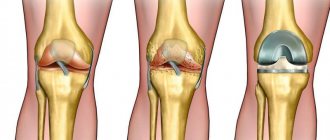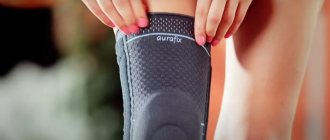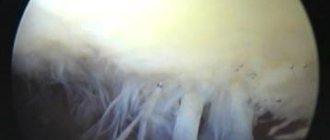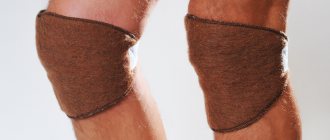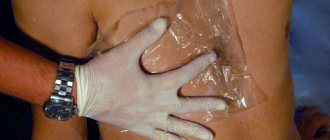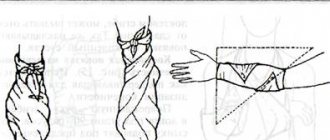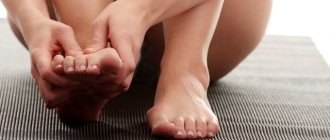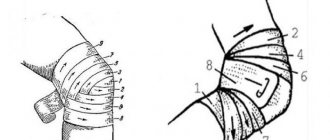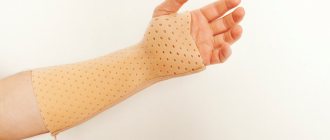The splint is a product that provides reliable fixation of the joint for quick recovery. A splint for the knee, ankle and hip joints allows you to eliminate movement and keep the limb in the correct position. This orthopedic product is prescribed to patients with limb injuries, neurological diseases and after surgery.
Specialists at the Yusupov Hospital Rehabilitation Center use modern methods to treat diseases and effectively rehabilitate patients. If indicated, rehabilitation doctors will select an orthosis and explain how to properly wear a brace on the knee joint.
Why do you need a knee splint?
The knee splint provides reliable fixation of the joint for quick recovery.
The knee brace limits movement as much as possible and keeps the leg in the correct position. This orthopedic product is prescribed for limb injuries, neurological diseases and after surgery.
Typically, a splint means an orthosis for the knee joint, the design of which does not have hinges. A rigid splint can be used to replace plaster for fractures, since the splint is designed to completely immobilize the joint.
In the production of knee splints, safe hypoallergenic materials are used that do not cause skin irritation. Modern manufacturers of orthopedic products produce various models of splints so that you can choose the appropriate type of design, size and material.
A knee brace is usually prescribed for the following conditions:
- arthrosis;
- dislocations and subluxations of the knee joint;
- ruptures of the cruciate and collateral ligaments;
- dislocations and fractures of the patella;
- “blockade” of the joint;
- hemorrhage into the joint cavity;
- after removal of plaster or after surgery.
Indications for use of the splint
Splints are used in traumatology and orthopedics after injuries and surgical interventions. Less commonly, these fixatives are prescribed for spasticity in neurological patients. We list the indications for mandatory use of a splint:
- Bruise and hemarthrosis of the knee joint. The presence of blood in the joint requires the creation of rest for the leg. But foot movements are encouraged, which is what can be done in the splint.
- A tear in the patellar ligament, its tendinitis. Eliminating the load on the patella is achieved by fixing the knee in an extended position.
- Arthroscopy of the knee joint. A splint is an essential component of rehabilitation after intra-articular operations. The duration of wearing and the type of product depends on the treatment option and the damaged structure itself.
- Endoprosthetics of the knee joint. The splint is prescribed at night to prevent contracture and form a beautiful scar.
- Other surgeries in the hip and knee area.
A good splint allows for dressings and monitoring of the wound or injured area. It can be removed or put on at night without outside help. Hypoallergenic, breathable fabric increases wearing comfort, and the minimal weight does not strain the foot.
How to choose a tutor?
Durable, reliable and comfortable splints are always available at Medtechnika Orthosalon. The products are certified and safe, tested over years of use in thousands of patients. In case of difficulties, specially trained consultants are ready to help with choosing a tutor. What options are there for such fasteners?
Most often, two types of splints are prescribed - with zero flexion in the knee joint and 20 degrees. Although the difference may seem small, the position of the knee joint after injury plays a critical role. In traumatology, it is customary to fix joints in their physiological position, and for the knee it is approximately equal to 10-20 degrees of flexion.
In a position of slight flexion, the posterior cruciate ligament, the posterior surface of the joint capsule, and the muscles of the posterior thigh relax. Therefore, the splint is 20-gr. prescribed after plastic surgery of the posterior cruciate ligament, restoration of the “harmstring” muscles, after interventions in the popliteal fossa.
A brace with a zero angle of flexion in the knee is relevant for the restoration of the anterior cruciate ligament, injuries of the patella and its ligaments, and ruptures of the quadriceps. In addition, this type of brace is needed to prevent flexion contracture of the knee joint.
The choice of a splint is the task of your attending physician, since only he can take into account all aspects of the existing pathology or operation. You can inspect, check and purchase the retainer both in the sales areas of Medtechnika Orthosalon and in a modern online store. More complex products are available - orthoses with adjustable flexion angle, bandages for rehabilitation, electrical muscle stimulators and products for reflexology.
Types of splints for the knee joint
Knee splints are divided into subtypes:
- therapeutic splints with rigid fixation are intended for the treatment of fractures, ligament ruptures, inflammatory processes in the joint, as well as for wearing after surgical operations;
- preventive splints of medium rigidity are used to prevent fractures due to osteoporosis and degenerative joint diseases;
- special splints of medium and low rigidity for patients with cerebral palsy.
The doctor may prescribe the patient to wear a splint to immobilize the knee joint in an extended state or a splint that fixes the limb in a bent position at 30 degrees.
Manufacturers produce splints of different sizes. Children's knee splints are produced for children.
Which orthosis should I choose based on the degree of rigidity?
Rigid and semi-rigid models are available. The product is selected taking into account the severity of the injury or disease, taking into account the stage of treatment and the requirements for fixation. In case of injury, it is recommended to choose a hard knee brace. It is indicated for sprains, fractures, dislocations.
Easy fixation
The products do not have stiffeners. They create compression and limit movement by a third. The indication for wearing is the prevention of injuries arising from physical activity. The product is worn to speed up the recovery process in case of sprains and inflammation, at the final stage of the post-traumatic or postoperative period. Prescribed for bursitis, pain, arthrosis, synovitis, exacerbation of arthrosis. For example, in our store, in this case, the knee joint fixator “Elast 9903” is suitable.
Semi-rigid fixation
Knee pads have spokes, tires, and stiffeners. They provide unloading and support, limiting movements by half. Products are indicated for joint instability, diseases, damage to the meniscus and ligaments, and for the prevention of sports injuries.
Maximum fixation
The models have stiffening ribs and additional elements. Orthoses limit movement by two-thirds or until complete immobilization. It is prescribed to be worn if complete immobilization of the joint is necessary. They do not allow mobility in certain directions. An excellent option in this case is the knee joint limiter MPE 12003. The product is indicated for severe injuries, after operations, for osteochondropathy, and osteoporosis.
If the fixation is insufficient, problems with the joint may worsen and the rehabilitation time will be delayed. On the contrary, excessively strong fixation impairs blood circulation and reduces muscle tone. To make the right choice, it is important to consult a specialist.
Tips for using a knee splint
When prescribing a knee splint for therapeutic or preventive purposes, the doctor must explain to the patient how to use the device.
Here we provide only general recommendations for wearing a splint:
- the device must be worn for a long time, removed only during hygiene procedures or medical examination;
- sometimes the doctor may allow you to remove the splint at night;
- The product should be put on in a lying position, with the knee slightly bent;
- The splint should not put too much pressure on the leg.
If you have any doubts about whether you are wearing the splint correctly, be sure to consult your doctor. Improper use can cause harm - cutting off circulation, causing pain, or placing even greater stress on the knee joint.
Selection by design type
Depending on the functions and purpose, manufacturers offer two types of orthoses: hinged and without hinges.
Full coverage of the damaged area is provided by a hingeless orthosis. Open and closed models are available in different materials.
- The elastic closed knee pad provides easy fixation of the kneecap and warms. Suitable for running and walking.
- Elastic open with tension adjustment is recommended for patients with damaged ligaments, minor pain due to arthritis, post-traumatic syndrome.
- Elastic open with lateral stiffening ribs in the form of spirals, recommended for pain during squats.
Hinged models have a movable joint and are made of tires, hinges, and springs. Products allow you to move in a certain direction. You can control the amplitude and angle of leg bending through the adjustments made. For fastening to the limbs, elastic straps, lacing and Velcro are used. The product is indicated for pain from a kneecap injury, meniscus damage and ligament rupture.
Where to buy a knee splint
Orthopedic salons Aesculapius in Rostov, Azov and Bataysk offer to buy splints and knee orthoses for adults and children.
Bandages, orthoses, splints from our range comply with the requirements of Russian legislation and industry regulations. All orthopedic products are provided with the necessary licenses and certificates.
Our specialists will select the appropriate model and explain how to properly wear a brace on the knee joint.
Share on social media networks:
Selection rules
When selecting a splint, you need to pay attention to the size, design and materials from which the orthopedic product is made.
You need to choose devices made from hypoallergenic materials; you should also pay attention to whether they allow air to pass through.
You also need to evaluate the reliability of the fastening so that you do not have to constantly adjust the bandage, which keeps slipping.
It should be taken into account that each manufacturer has its own range of sizes. Some companies recommend measuring the knee circumference to select the appropriate size, others recommend measuring the hip circumference in the middle and then compare the resulting numbers with the information indicated on the packaging.
It is forbidden to purchase a brace without first consulting a specialist; before the final purchase, you must try on the brace and evaluate whether it is comfortable in it. The knee should be locked from the upper third of the thigh to the lower third of the shin.
It is worth taking a particularly responsible approach to choosing a tutor for a child. It is better to make it to order, taking into account the personal characteristics of the patient.
A children's tutor must meet the following requirements:
- be light;
- differ in wear resistance;
- be hypoallergenic and safe for health;
- fix the knee well;
- Easily adjustable.
In custom-made splints, a child can not only walk during the day, but also sleep in them. Typically, such orthopedic products are worn for a long time, so for children they are made from elastic and durable materials that are breathable. The design of the device is detachable, which allows you to remove it, for example, when you need to take a bath and perform therapeutic procedures.
Rules for caring for orthopedic products
In order for a splint to last longer, it must be properly cared for:
- The product cannot be washed in a washing machine;
- the water temperature for washing should not exceed 40 degrees;
- It is forbidden to dry the product in a drum, twist it, bleach it or iron it;
- during washing, the splint should be “fastened”;
- It is better to use neutral soap rather than powder for washing;
- The product should be dried flat, away from heating appliances.

